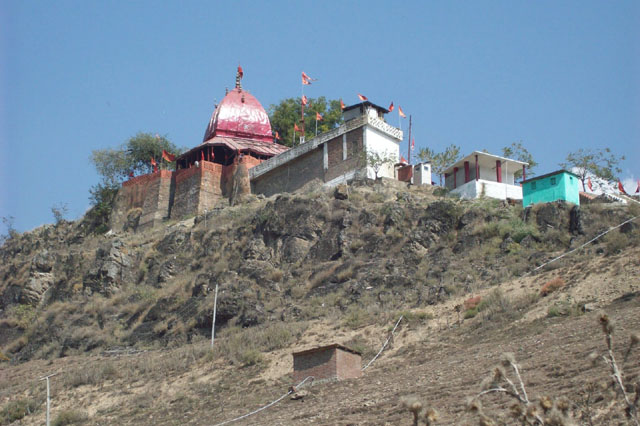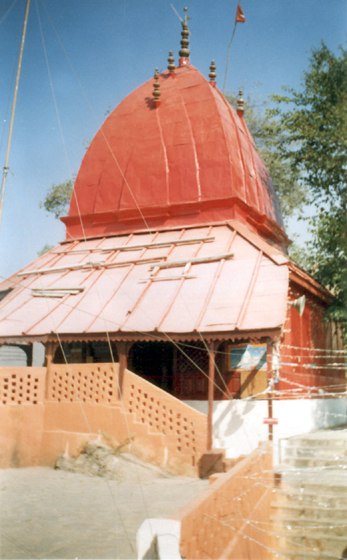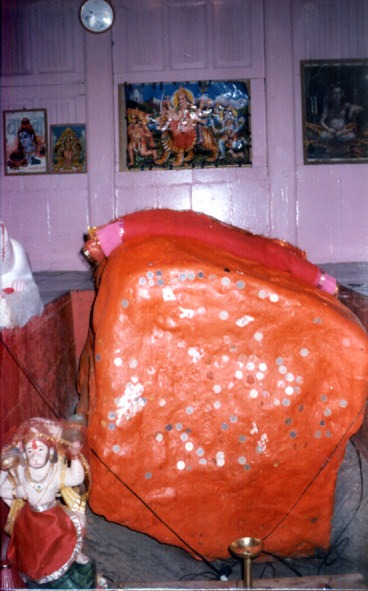by Chander M. Bhat
Village Khrew, in Vihi
Pargana is in the South-East of Srinagar at a distance of 20 km. This village is
located at 34.02oN and 74.980E. It has an average
elevation of 1,067 metres (5,272 feet).

Village Loduv is in the East of
village Khrew. This village is famous for the abode of Jeevan Sahib and for two
ancient temples. According to Guldastai Kashmir by Harpogal Koul, Loduv Pandit,
a minister of Raja Saka during 2409-72 KE founded this village. Loduv Pandit
also built a temple there which is presently under the control of Archaeological
Survey of India. Total area of the village is 904.87 hectares and as per 1981
Census total population of this village was 2820 souls comprising of 369
households. Kashmiri Pandit community comprises 24 percent of total population
of the village comprising of 57 households. Eight households have held back
after the mass exodus of Kashmiri Pandits from the valley in the year 1990.
Village Wuyan is about 2 km to
the West of Village Khrew. It was known as Ovana formerly. The first factory in
Jammu and Kashmir for the manufacture of cement was installed at Wuyan.
Ovana (Wuyan) was burnt during the civil war between the Kashmiris and the
immigrant Syeds in 1484 A.D. The name of the village changed from Ovana (Uvana)
to Vuyan and then to Wuyan. There were 15 Kashmiri Pandit living in this village
before mass exodus. All the families have migrated to other parts of India in
1990.There are few sulphur springs in this village besides a big and deep spring
locally known as Kaiz Nag. It is said that a fish in this spring was having
golden ear rings and the said fish was visible on the day of Ashtami only.
Balhom or Balhama village is in
the  South
of village Khrew. This village is famous for Baladevi Shrine. Baladevi was the
Isht Devi of Dogra Rulers. At present the temple is having a deserted look due
to lack of maintenance and proper care due to forced migration of Pandit
families from this village. Two pandit families are still residing in this
village.
South
of village Khrew. This village is famous for Baladevi Shrine. Baladevi was the
Isht Devi of Dogra Rulers. At present the temple is having a deserted look due
to lack of maintenance and proper care due to forced migration of Pandit
families from this village. Two pandit families are still residing in this
village.
Village Shar lies in North East
of village Khrew. This village is the birthplace of famous mystic poet Wahib
Sahab (Khar). Kalhana mentions it by the name of Sanara as an Agrahara founded
by King Sacinara.
Other small villages like
Androssa, Bathen, Nagandar and Satpokhran are also to its surroundings.
Village Khrew has a population
of 18,820 souls as per 2011 census. About 50 Kashmiri Pandit families were
forming the part of population in this village before 1990. Khrew had a history
of having 360 natural springs but currently only 7 springs flow through this
town. Once known for their crystal clear waters, these water bodies have lost
their traditional stature to one reason or the other. Village Khrew is also the
best producer of saffron and has been graded as the fourth cultivator of saffron
in India. Amanullah Khah Sahab, Baba Qasim Sahab, Sabir Shah and Syed Mantaqi
are the holy places of Muslims in village Khrew.
Popularly known as Zaala
Bhagwati, the Shrine of Mata Jwalaji at Khrew is one of the ancient shrines of
Kashmir. Jwalaji is the Isht Devi of many Kashmir Pandit families. Kalhana
refers to the village in Rajtarangini as ‘Khaduvi’ where according to him;
there were three hundred and sixty fresh water springs. Kalhana further mentions
that on the hill side to the east of the village, was a standing rock on which a
mystical diagram was drawn. The shrine has a holy spring locally called Bod Nag
or Aneek Nag at the base of the hillock. It is also known as Nagabal. Pilgrims
used to take a dip in this spring before making the ascent. This spring is 40
feet wide and 60 feet in length and 3 feet deep. Fresh and cold water is oozing
at the South West corner of this spring. Some idols believed to be some
six hundred years old are standing at this oozing point. This spring
abounds in fish. Recently a small island has been constructed in the centre of
this spring. This spring under the shade of three Chinar Trees presents a
magnificent look. There is also a walnut tree on the bank of this spring. The
water of this spring flows out into a stream, passes through the compounds of
some Kashmiri Pandit houses and thereby is used for irrigation purpose. In my
childhood days I alongwith my respected parents used to go to Khrew to one of
our relatives and would stay there for four to five days. I still remember that
this stream was flowing underneath the house of my relative namely Pandit
Sarwanand Bhat.
The octagonal shaped temple is
reached by a flight of 320 dressed devri stone steps. It is believed that Raja Daya Krishan Koul has built
this temple during Dogra Rule. Pilgrim pays obeisance at the Ganesh temple on
the left side of the stair before reaching main sanctum sanatorium. The shrine
of Jwalaji is situated on top of the hillock overlooking village Khrew. The main
sanctum sanctorum is 12 feet by 12 feet square shaped structure. The ceiling of
the dome is decorated with Khatamband (Vaastalav/Wood Carving) design. The
structure of the shrine resembles of the aspect and architecture of the pagodas
of China, but the slope of the roof is straight instead of being concave.
Its basement, six to eight yards square, is of stone, raised a few feet from the
ground. On the front side of the shrine wooden plates have been placed (called
Voorusi in Kashmiri) and these plates can be placed on the top of the front wall
and opens the front portion completely. There is a Shilla inside the sanctum
sanctorum, in the form of a natural stone measuring 4 feet height, 4 feet length
and 3 feet width, smeared with Sindhur. It is said that Jwalaji manifested
herself all the time as a jyoti sometime in the past. There is no firm base over
which this sacred shilla has been placed and it is believed that the Shilla is
stationary and is floating in air. This sacred Shilla has naturally carved
mystical lines forming triangles and hexagons in the shape of Sri Chakra. It is
further believed that the Shilla turned black due to the occasional flames which
sparked here from time to time. One has to flight some 6 stairs for making
parikrama of the shrine. Above the main shrine, there is a small temple
dedicated to Bhariava. Tahar (yellow rice) and Shooshnoor (lamb’s lung) is
being offered to the Bhariava. A revered hill ‘Vishnu Pad’ is on the left
side of this shrine. There is a foot mark at the top of Vishnu Pad. As per the
legend this foot mark is believed to be of Lord Vishnu. In olden days pilgrims
used to visit this hill also and but with the passage of time this practice was
stopped.
devri stone steps. It is believed that Raja Daya Krishan Koul has built
this temple during Dogra Rule. Pilgrim pays obeisance at the Ganesh temple on
the left side of the stair before reaching main sanctum sanatorium. The shrine
of Jwalaji is situated on top of the hillock overlooking village Khrew. The main
sanctum sanctorum is 12 feet by 12 feet square shaped structure. The ceiling of
the dome is decorated with Khatamband (Vaastalav/Wood Carving) design. The
structure of the shrine resembles of the aspect and architecture of the pagodas
of China, but the slope of the roof is straight instead of being concave.
Its basement, six to eight yards square, is of stone, raised a few feet from the
ground. On the front side of the shrine wooden plates have been placed (called
Voorusi in Kashmiri) and these plates can be placed on the top of the front wall
and opens the front portion completely. There is a Shilla inside the sanctum
sanctorum, in the form of a natural stone measuring 4 feet height, 4 feet length
and 3 feet width, smeared with Sindhur. It is said that Jwalaji manifested
herself all the time as a jyoti sometime in the past. There is no firm base over
which this sacred shilla has been placed and it is believed that the Shilla is
stationary and is floating in air. This sacred Shilla has naturally carved
mystical lines forming triangles and hexagons in the shape of Sri Chakra. It is
further believed that the Shilla turned black due to the occasional flames which
sparked here from time to time. One has to flight some 6 stairs for making
parikrama of the shrine. Above the main shrine, there is a small temple
dedicated to Bhariava. Tahar (yellow rice) and Shooshnoor (lamb’s lung) is
being offered to the Bhariava. A revered hill ‘Vishnu Pad’ is on the left
side of this shrine. There is a foot mark at the top of Vishnu Pad. As per the
legend this foot mark is believed to be of Lord Vishnu. In olden days pilgrims
used to visit this hill also and but with the passage of time this practice was
stopped.
After having darshan pilgrims
can decent through a different route (leading to Daibdather, Dobi Ghat) which is
rough. After descending a few yards, the pilgrim can slide on the slippery slope
of the hillock (Rikinei Wosun) to reach Daibdather. It is believed that this
slide on this slippery slope is the final stage of the pilgrimage. I
remember during my childhood, we used to go to this village every year by hiring
a horse driven cart especially Khaliq Tangeh from my native village Murran,
carrying all the essential commodities and used to stay in open at Daibdather (Dobi
Ghat) on the foot of the Zabarwan Mountain for three to four during Mela Jwalaji
i.e. on 14th bright fortnight of Ashada (June-July).
The birthday of Goddess Jwalaji
is being celebrated on Ashad Shukla Chaturdashi, fourteen bright fortnight of
June-July also called Jwala Chaturdashi, every year and a grand festival is
being held at village Khrew. It was a routine that the relatives of the Kashmiri
Pandits residing at Village Khrew used to come to this village for three to four
days.
Notes and References
